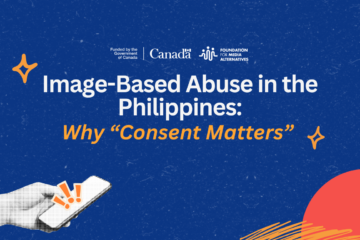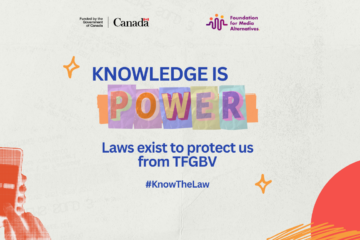The Modern Age of Filipino Feminism: Digital Activism, Social Media, and Gendered Disinformation
– Wondermore, @Wmore, May 28, 2018, Tweet
Over the years, studies have shown that women are attacked online through harassment, abuse, and gendered disinformation campaigns at far greater rates than men, with alarming increases of online gender-based violence over the coronavirus pandemic. An emerging trend is the use of disinformation and defamation as a means to harm women online. Part 1 of the “Weaponizing Social Media Against Women” blog series takes an in-depth exploration of what gendered disinformation is and what tactics are typically employed. (Read Part 1: Gendered Disinformation: Attacking Women for Being Female, Online, and Politically Outspoken)
Women in politics and female journalists are especially targeted in gendered disinformation campaigns and coordinated online abuse. Part 2 of the blog series discussed how an information war is being waged against female politicians and journalists — and, ultimately, how gendered disinformation extends beyond “women’s issues” and undermines democracy. (Read Part 2: The Info War Against Women in Politics: How Social Media is Weaponized Against Female Politicians, Journalists, and (Ultimately) Democracy)
But what is being done about it?
Women are “Taking Back the Tech”
More than just passive recipients of online hate, women in politics have been actively “taking back the tech.” A global survey found that 86% of female legislators make some use of social media, especially during electoral campaigns. Social media platforms have been especially useful in helping female politicians overcome the marginalization and bias they face in traditional media by being able to communicate directly with their constituents and voters on their own terms. Research in Europe and Israel also suggest that female politicians and candidates are more adept, effective, and creative in using social media than their male colleagues, and can generate significantly more user engagement through follows and likes on their posts.
Globally, civil society organizations and women activists have raised awareness around gendered disinformation and online gender-based violence with international advocacy initiatives. Hashtag feminism campaigns, such as #NotTheCost in the United Kingdom, #WebWithoutViolence in Germany, and #BetterThanThis in Kenya, have garnered international attention. The United States Democratic Women’s Caucus wrote an open letter to Facebook demanding better protection of women from online abuse. Civil society organizations, such as Foundation for Media Alternatives (FMA), continue to provide specialized training on digital security and OGBV for young female activists.
Young Filipina Feminists
In the Philippines, women are supporting other women, especially in campaigns championed by young Filipina activists. As stated by the Women’s Legal and Human Rights Bureau: “The activism of young feminists speaks for itself. We’re out on the streets, we’re starting our own online communities, and we’re pioneering a feminist revolution of our own terms.” #BabaeAko (I am a woman) and #HijaAko (I am a young woman) have garnered massive support with Filipinas sharing personal accounts of sexual harassment, denouncing rape culture in the Philippines, and calling out sexism and misogyny. Civil society projects such as FMA’s Take Back the Tech! and Plan International’s Cyber Safe Spaces project empower young people to harness the use of ICTs to reach out and pass on knowledge of digital safety and OGBV awareness training to peers online.
This new generation of feminists in the Philippines have reclaimed technology as a means of combating OGBV and gendered disinformation. They are encouraging more dynamic, interpersonal, and affective approaches to facilitate deeper dialogue on issues, resonating strongly with the everyday experiences of young Filipina women.
What Can Be Done About Gendered Disinformation?
Currently, the responsibility of identifying and reporting OGBV and gendered disinformation largely rests on the shoulders of users in the online community. Measures used by social media platforms, however, have been grossly inadequate. The automated bots and tools tech platforms tend to gravitate to are blunt, culturally insensitive, and prone to bias. The Facebook Papers and research on YouTube paint a grim image of how non-English languages have allowed hate speech to thrive on social media platforms. Automated bots are unable to detect the malign creativity often employed in gendered disinformation, and they often lack testing and consultation with local experts who have comprehensive knowledge of the relevant context.
Addressing gendered disinformation and online misogyny will require a multi-stakeholder, coalition-based approach, engaging policy makers, international institutions, ICT platforms, the media, civil society organizations, academics, and women activists. Many researchers and advocates propose that a shift towards a more proactive, intersectional approach to gendered disinformation needs to occur, rather than rely solely on the current “mute, report, block, delete” approach.
What Social Media Platforms Need to Do
Social media platforms need to be more transparent in how they define hate speech and disinformation, how algorithms curate contents for users, and whether moderators are trained with a gender-sensitive and culture-sensitive lens. Platforms also need to engage with and consult local experts to improve early warning systems, ongoing threat assessments, and moderation tools. Users should be empowered in the process of submitting reports of abuse and harassment by allowing them to report multiple posts at once and being able to provide context to their abuse. Furthermore, social media platforms should aid research in gendered disinformation by making their data more easily accessible and share results on how their interventions affect the spread of disinformation. However, governments should not solely depend on social media platforms to effect change on gendered disinformation.
What Governments Need to Do
Governments also need to legislate to ensure social media platforms are meeting gender-sensitive design standards, introduce gender-sensitive standards that are upheld by politicians (especially during election campaigns), and require action against gendered disinformation. Legal reforms should be paired with corresponding resources and training for law enforcement, so they can properly and effectively handle online gender-based violence. More broadly, governments need to disincentivize social media algorithms that profit off gendered disinformation. Governments also need to work in collaboration with civil society organizations and activists to build early warning systems, invest in digital literacy initiatives, and support research of gendered disinformation affecting female political actors and women in general.
While more Filipina women are getting involved in public service every year, they still only comprise one-fifth of the government. Thus, in light of the upcoming 2022 elections in the Philippines, it will be more crucial than ever to prevent gendered disinformation from beginning. More work needs to be done by social media platforms, media organizations, and the government, in collaboration with civil society, female activists, and local experts to reduce the spread of gendered disinformation throughout the electoral campaign period and to respond to existing gendered disinformation campaigns.
Summing It All Up:
- Women in politics have been “taking back the tech,” especially in the use of social media during electoral campaigns to overcome marginalization and bias in traditional media.
- Globally, civil society and feminists have raised awareness around gendered disinformation and online gender-based violence (OGBV) with international advocacy initiatives.
- In the Philippines, women are supporting women through digital activism, such as the #BabeAeko and #HijaAko campaigns, and digital safety training championed by young Filipina feminists.
- The measures used by social media platforms are not enough; the majority of automated bots and tools used are blunt, culturally insensitive, and prone to bias.
- Language gaps provide loopholes for hate speech to flourish on social media platforms. Platforms need to better engage with local experts with more knowledge in the relevant regional context these platforms operate in.
- Governments should not depend solely on social media companies to effect change on OGBV and gendered disinformation.
- Social media platforms, media organizations, and governments need to work in collaboration with civil society, feminists and local experts to shift towards a more proactive approach and away from the current “mute, report, block, delete” approach.
About the author:
This article is written by Sheila Lau, an intern from Canada working at the Foundation for Media Alternatives (FMA). Blog articles written by the author do not necessarily reflect the views and opinions of FMA.



0 Comments